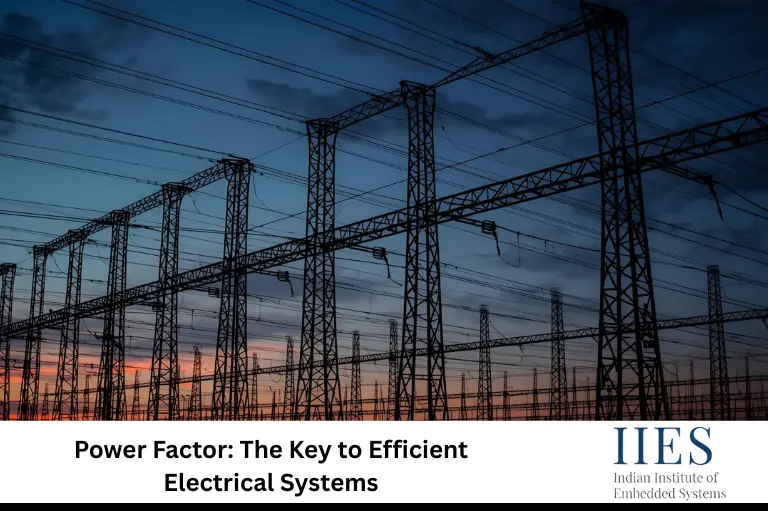
Power Factor (PF) is a key concept in electrical engineering that measures the efficiency with which electrical power is converted into useful work. A high power factor means better energy utilization, while a low power factor indicates wasted energy and higher operating costs.
Power Factor plays a vital role in optimizing industrial power systems. By understanding and applying power factor correction and power quality analysis, engineers and students can minimize energy losses, improve voltage stability, and design more reliable and efficient electrical systems, especially in embedded and automation applications.
Power factor is the ratio of real power (kW) to apparent power (kVA) in an AC circuit. It indicates how efficiently electrical energy is converted into useful output.
Power Factor (PF) = Real Power (P) / Apparent Power (S) = cosθ
A high power factor (close to 1) indicates a highly efficient system, while a low power factor suggests wasted energy due to reactive components, such as motors and transformers.
In AC circuits, the power triangle visually represents the relationship between real power (P), reactive power (Q), and apparent power (S).
| Type of Power | Symbol | Unit | Description |
| Real Power | P | kW | Actual useful power that performs work |
| Reactive Power | Q | kVAR | Power oscillating between the source and the load |
| Apparent Power | S | kVA | A combination of both real and reactive power |
S² = P² + Q², where θ is the power factor angle, and cosθ represents the power factor.
The Power Factor (PF) represents the cosine of the phase angle (θ) between voltage and current in an AC circuit. It shows how efficiently electrical power is being used.
Power Factor (PF) = cosθ = P/S
Low power factor is primarily caused by inductive and non-linear loads that consume reactive power.
Improving power factor helps reduce power losses, improve voltage regulation, and eliminate power factor penalties from utilities.
This method uses capacitor banks to supply reactive power, balancing the inductive effects of loads.
Qc = P × (tanθ₁ − tanθ₂)
Used in modern systems, active PFC circuits use electronic controllers to dynamically adjust current and voltage phase.
To maintain reliable operation, power quality analysis is essential.
| Parameter | Ideal Value | Poor Value |
| Power Factor | 0.95–1.0 | < 0.8 |
| THD Voltage | < 5% | > 10% |
| THD Current | < 10% | > 30% |
A capacitor bank is the most widely used power factor correction circuit in industries. It generates leading reactive power to neutralize the lagging reactive power of inductive loads.
Utilities often impose a power factor penalty for systems operating below 0.9. Improving PF not only avoids penalties but also increases efficiency.
| Aspect | Automatic (Passive) | Manual (Active) |
| Type | Fixed capacitor banks | Dynamic electronic circuits |
| Speed | Fast but limited | Slower but flexible |
| Control | Simple and automatic | Adaptive and intelligent |
| Lifetime | Fixed compensation | Adjustable correction |
Optimizing power factor is one of the simplest yet most impactful ways to improve electrical efficiency. A good power factor correction strategy reduces losses, lowers costs, and enhances stability. With smart IoT-based APFC panels, maintaining PF above 0.95 is easier than ever, helping industries save energy, prevent penalties, and ensure smooth operations.
Power factor shows how efficiently electrical energy is used. A higher PF means less wastage and better voltage stability.
By using capacitor banks, active PFC circuits, and harmonic filters.
Depends on load size and desired PF level; payback is typically within a year.
THD (Total Harmonic Distortion) measures waveform distortion; high THD leads to losses and overheating.
An APFC panel automatically adjusts capacitors to maintain an optimal PF under varying loads.
Indian Institute of Embedded Systems – IIES